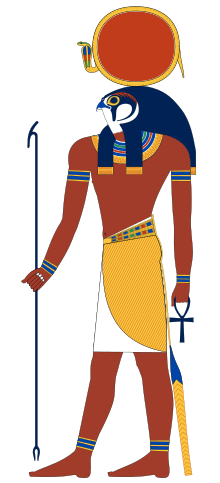
Back Ra Afrikaans Re ALS رع Arabic رع ARZ ৰা (সূৰ্যদেৱতা) Assamese Ra Azerbaijani Ра Bashkir Ра Byelorussian Ра BE-X-OLD Ра Bulgarian
| Ra | |||||||||||
|---|---|---|---|---|---|---|---|---|---|---|---|
 | |||||||||||
| Name in hieroglyphs |
or
or
| ||||||||||
| Major cult center | Heliopolis but was worshipped everywhere in Ancient Egypt. | ||||||||||
| Symbol | Sun Disk | ||||||||||
| Personal information | |||||||||||
| Parents | None (most accounts) Khnum and Neith (alternative sources) Hathor (In the cycle of rebirth) Mehet-Weret (some accounts) | ||||||||||
| Siblings | Apep, Sobek and Serket (as son of Khnum and Neith) | ||||||||||
| Consort | Hathor, Sekhmet, Bastet, Satet (in some myths) | ||||||||||
| Offspring | Shu, Tefnut, Hathor, Sekhmet, Mafdet, Bastet, Satet, Anhur, Ma'at, Mut | ||||||||||
| Equivalents | |||||||||||
| Greek equivalent | Helios[1] | ||||||||||
Ra (/rɑː/;[2] Ancient Egyptian: rꜥ; also transliterated rꜥw /ˈɾiːʕuw/; cuneiform: 𒊑𒀀 ri-a or 𒊑𒅀ri-ia;[3] Phoenician: 𐤓𐤏,[4] romanized: rʿ) or Re (/reɪ/; Coptic: ⲣⲏ, romanized: Rē) was the ancient Egyptian deity of the Sun. By the Fifth Dynasty, in the 25th and 24th centuries BC, he had become one of the most important gods in ancient Egyptian religion, identified primarily with the noon-day sun. Ra ruled in all parts of the created world: the sky, the Earth, and the underworld.[5] He was believed to have ruled as the first pharaoh of Ancient Egypt.[6][7] He was the god of the sun, order, kings and the sky.
Ra was portrayed as a falcon and shared characteristics with the sky-god Horus. At times, the two deities were merged as Ra-Horakhty, "Ra, who is Horus of the Two Horizons". When the god Amun rose to prominence during Egypt's New Kingdom, he was fused with Ra as Amun-Ra.
The cult of the Mnevis bull, an embodiment of Ra, had its center in Heliopolis and there was a formal burial ground for the sacrificed bulls north of the city.
All forms of life were believed to have been created by Ra. In some accounts, humans were created from Ra's tears and sweat, hence the Egyptians call themselves the "Cattle of Ra". In the myth of the Celestial Cow, it is recounted how humankind plotted against Ra and how he sent his eye as the goddess Sekhmet to punish them.
- ^ Hart, George (2005). The Routledge Dictionary of Egyptian Gods and Goddesses. Routledge. p. 110. ISBN 0-415-34495-6.
- ^ Merriam-Webster's Collegiate Dictionary, Eleventh Edition. Merriam-Webster, 2007. p. 1023
- ^ Hess, Richard S. (1993). Amarna Personal Names. Eisenbrauns. ISBN 9780931464713. Archived from the original on 2017-12-16.
- ^ CIS I 3778
- ^ Hart, George (2005). The Routledge Dictionary of Egyptian Gods and Goddesses. Psychology Press. p. 133. ISBN 978-0-415-34495-1.
- ^ "Ra, the Sun God | Ancient Egypt Online". Retrieved 2023-05-22.
- ^ "Ra | Encyclopedia.com". www.encyclopedia.com. Retrieved 2023-05-22.
© MMXXIII Rich X Search. We shall prevail. All rights reserved. Rich X Search